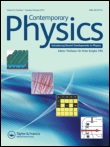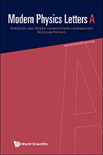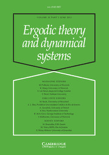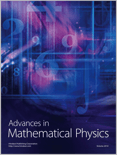
CELESTIAL MECHANICS & DYNAMICAL ASTRONOMY
metrics 2024
Illuminating Celestial Paths: Where Mathematics Meets Astronomy
Introduction
CELESTIAL MECHANICS & DYNAMICAL ASTRONOMY is an esteemed journal published by Springer, dedicated to advancing the field of celestial mechanics, dynamical astronomy, and related disciplines. With an ISSN of 0923-2958 and an E-ISSN of 1572-9478, this journal has been a vital resource since its inception in 1989 and continues to provide invaluable insights up to 2024. Recognized for its impactful research, it holds a Q2 ranking in multiple categories, including Applied Mathematics and Astronomy and Astrophysics, indicating its significance in both academic and practical applications. Researchers and professionals can expect a curated selection of innovative studies that foster a deeper understanding of the dynamics of celestial bodies and the mathematical principles governing them. The journal is committed to maintaining high standards and contributes to interdisciplinary discourse, making it a preferred choice for those engaged in cutting-edge research in astronomy, astrophysics, and computational mathematics.
Metrics 2024
 0.52
0.52 1.60
1.60 1.80
1.80 65
65Metrics History
Rank 2024
Scopus
IF (Web Of Science)
JCI (Web Of Science)
Quartile History
Similar Journals

CONTEMPORARY PHYSICS
Bridging Theory and Application in Modern PhysicsCONTEMPORARY PHYSICS, published by Taylor & Francis Ltd, stands as a notable journal in the field of physics and astronomy, offering a comprehensive platform for the dissemination of cutting-edge research and developments since its inception in 1959. With an Impact Factor that reflects its solid position within the academic community, as evidenced by its Q2 ranking in the 2023 category of Physics and Astronomy (miscellaneous) and a Scopus Rank of 111 out of 243, this journal plays an essential role in bridging theoretical advances and practical applications. Researchers and professionals are encouraged to explore its diverse scope, which aims to foster innovative ideas and foster interdisciplinary collaboration. Although not currently an open access journal, CONTEMPORARY PHYSICS is committed to maintaining the highest standards of editorial excellence and provides valuable insights across converged eras of research from 1959 to 2024, making it indispensable for those dedicated to advancing their knowledge and contributions in the realm of physics.

MODERN PHYSICS LETTERS A
Advancing the Frontiers of Physics ResearchMODERN PHYSICS LETTERS A, published by World Scientific Publishing Co Pte Ltd, is a distinguished journal in the field of physics that serves as a pivotal platform for researchers, professionals, and students alike. With ISSN 0217-7323 and E-ISSN 1793-6632, the journal has gained international acclaim for its contributions to Astronomy and Astrophysics as well as Nuclear and High Energy Physics. The journal is ranked in Q3 for both Astronomy and Astrophysics and Nuclear and High Energy Physics, showcasing its relevance in these areas, while also achieving a Q2 ranking in the broader category of Physics and Astronomy (miscellaneous). Spanning from 1996 to 2024, MODERN PHYSICS LETTERS A promotes open dialogue and dissemination of pioneering research findings and innovative theories. While the journal operates without an open access option, its rich content is easily accessible through various academic databases, ensuring that vital research is shared widely among the scientific community. Situated in Singapore, this journal plays an essential role in the continuous advancement of the physics discipline, fostering collaboration and knowledge sharing among global researchers.

ZEITSCHRIFT FUR ANALYSIS UND IHRE ANWENDUNGEN
Connecting Scholars to the Heart of Mathematical AnalysisZEITSCHRIFT FUR ANALYSIS UND IHRE ANWENDUNGEN, published by the European Mathematical Society, stands as a vital resource in the fields of analysis and applied mathematics. With an ISSN of 0232-2064 and E-ISSN 1661-4534, this esteemed journal has been disseminating high-quality research since its inception in 1996, converging its efforts through 2024. Recognized within Q2 quartiles of both analysis and applied mathematics categories, it ranks #98 out of 193 in Mathematics _ Analysis and #379 out of 635 in Mathematics _ Applied Mathematics according to Scopus, affirming its significant impact within the academic community. Although not open access, the journal provides a platform for rigorous peer-reviewed articles that foster the interplay between theoretical insights and practical applications, catering to the needs of researchers, professionals, and students alike. With its editorial board comprised of leading experts, ZEITSCHRIFT FUR ANALYSIS UND IHRE ANWENDUNGEN continues to advance mathematical knowledge, making it an essential journal for those aiming to stay at the forefront of analysis and its applications.

COMPTES RENDUS PHYSIQUE
Navigating the Evolving Landscape of Physics TogetherCOMPTES RENDUS PHYSIQUE, published by the esteemed Académie des Sciences, is a prestigious open access journal dedicated to the advancement of knowledge in the field of Physics and Astronomy. Since its inception, it has established a significant presence in the academic community, achieving an impressive Q2 ranking for the year 2023 in its category and holding a respectable 116th place within the Scopus rankings for General Physics and Astronomy. COMPTES RENDUS PHYSIQUE not only serves as a platform for high-quality research articles, reviews, and discussions but also strives to facilitate the dissemination of crucial scientific findings to a global audience, reflecting its commitment to open access since 2020. Based in Paris, France, the journal aims to bridge the gap between theoretical research and practical applications, supporting researchers, professionals, and students who seek to stay at the forefront of technological and scientific innovation. With its comprehensive coverage from 2002 to 2024, COMPTES RENDUS PHYSIQUE remains a vital resource for anyone engaged in the ever-evolving landscape of physics.

Advances in Astronomy
Connecting Researchers to the Wonders of the Universe.Advances in Astronomy is a prestigious open-access journal published by HINDAWI LTD, dedicated to the field of astronomy and astrophysics. Established in 2008, the journal aims to disseminate significant research findings and advancements in the understanding of celestial phenomena, planetary sciences, and the intricate workings of the universe. With an impact factor that reflects its relevance in the scholarly community, Advances in Astronomy holds a commendable rank of Q3 in both Astronomy and Astrophysics as well as Space and Planetary Science categories, indicating its importance within these fields. The journal also showcases a commitment to open-access publishing, ensuring that research is readily available to both the scientific community and the public. Researchers, professionals, and students alike are encouraged to contribute to this dynamic forum to share knowledge and foster collaboration in exploring the wonders of the cosmos.

ERGODIC THEORY AND DYNAMICAL SYSTEMS
Fostering Scholarly Discourse in MathematicsERGODIC THEORY AND DYNAMICAL SYSTEMS is a premier academic journal published by Cambridge University Press, dedicated to the intricate fields of ergodic theory and dynamical systems. With an ISSN of 0143-3857 and E-ISSN 1469-4417, the journal serves a global audience from its base in the United Kingdom. Renowned for its rigorous peer-reviewed content, it boasts a prestigious Q1 classification in both Applied Mathematics and Mathematics (miscellaneous) categories as of 2023 and enjoys a significant rank in the Scopus database, highlighting its impact in the mathematical community. The journal encompasses high-quality research and innovative methodologies spanning from the foundational aspects of ergodic theory to practical applications in various fields, making it an indispensable resource for researchers, professionals, and students alike. With a commitment to advancing mathematical understanding, ERGODIC THEORY AND DYNAMICAL SYSTEMS is a vital platform for disseminating exceptional research and fostering scholarly discourse through its continuous publication cycle from 1981 to 2024.

DISCRETE AND CONTINUOUS DYNAMICAL SYSTEMS
Advancing the frontiers of mathematical exploration.DISCRETE AND CONTINUOUS DYNAMICAL SYSTEMS is a prestigious academic journal published by the American Institute of Mathematical Sciences (AIMS), dedicated to the dissemination of high-quality research in the fields of Discrete Mathematics, Applied Mathematics, and Dynamical Systems. With an impressive impact factor that places it in the Q1 quartile of several mathematical categories, including an outstanding rank of #20 in Discrete Mathematics and Combinatorics, this journal serves as an essential platform for researchers, professionals, and students to explore innovative methodologies and applications. Since its inception in 1996, the journal has partaken in the convergence of mathematical theories, with its editorial board committed to publishing cutting-edge studies up until 2025. Although it is not open access, the journal's rigorous peer-review process ensures that each article maintains the highest scholastic standards, making it a vital resource in the advancement of mathematical sciences.

Kinematics and Physics of Celestial Bodies
Exploring the Dynamics of the CosmosKinematics and Physics of Celestial Bodies is a prominent journal published by PLEIADES PUBLISHING INC, dedicated to the exploration and understanding of celestial mechanics and the physical properties of astronomical bodies. With an ISSN of 0884-5913 and an E-ISSN of 1934-8401, this journal has established itself as a resource for researchers in the fields of astronomy, astrophysics, and space science since its inception in 2009. The journal is indexed in Scopus, where it currently ranks in the fourth quartile for both Astronomy and Astrophysics and Space and Planetary Science, making it a valuable platform for scholarly discourse despite its ranking. Its scope encompasses a range of topics related to the kinematics and physical characteristics of celestial objects, aiming to facilitate a better understanding of their dynamics and interactions within the universe. Although it does not operate under an open access model, the journal provides essential insights and findings, catering to the academic needs of researchers, professionals, and students engaged in the study of the cosmos. The journal's commitment to advancing knowledge in the various aspects of celestial physics ultimately contributes to the broader scientific community's endeavors.

Journal of Dynamics and Differential Equations
Pioneering Research in Dynamics and Differential EquationsJournal of Dynamics and Differential Equations, published by SPRINGER, is a premier academic journal dedicated to advancing the understanding of dynamic systems and their mathematical foundations. Operating since its inception in 1989, the journal has become a vital resource for researchers and practitioners in the field, boasting a commendable Q1 ranking in the Analysis category as of 2023 and ranking #39 out of 193 journals in Mathematics Analysis on Scopus, placing it in the 80th percentile. While it maintains a traditional subscription model, its substantial contributions to the mathematics community—measured by a robust impact and adherence to high academic standards—make it essential reading for those engaged in differential equations and dynamical systems. The journal covers a broad scope of theoretical and applied research, positioning itself as a cornerstone for innovative studies and discussions, and ensuring its relevance to both contemporary and future mathematical inquiries.

Advances in Mathematical Physics
Fostering Collaboration in Mathematical PhysicsAdvances in Mathematical Physics is a premier open-access journal published by HINDAWI LTD, dedicated to the dissemination of research in the fields of applied mathematics and physics. With its ISSN 1687-9120 and E-ISSN 1687-9139, this journal has been a vital platform for innovative studies since its inception in 2009, fostering a collaborative environment for researchers and professionals alike. The journal features a wide range of topics, including but not limited to mathematical models, computational physics, and interdisciplinary applications, thus attracting a diverse readership. Ranked in the Q3 quartile for both Applied Mathematics and Physics and Astronomy, it serves as a significant resource for academics looking to explore cutting-edge developments and theoretical advancements. With an emphasis on open accessibility, Advances in Mathematical Physics ensures that research findings are readily available to the global academic community, leveling the playing field for emerging scholars and seasoned researchers. By consistently showcasing high-quality manuscripts, the journal contributes substantially to the fields of mathematics and physics, encouraging scholarly dialogue and advancing knowledge across a myriad of applications.